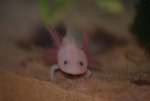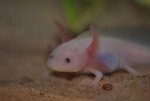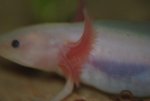It doesn't look bitten to me. As a geneticist, though, I have to point out there's a third option. Almost every organism has some small anomalies that aren't based on the genome, but on which cells proliferated, lived, or died during development and growth, which is somewhat random. The prime example is the domestic cat's spots -- the general extent of the spotting is genetically determined, but precisely where the spots wind up is different even in genetically identical animals. (One major exception is the worm Caenorhabditis elegans, where every single animal has the same number of the same cells. Whoa.) So unless Majora has two gill stalks on both sides, which would be much more likely to be genetic, my guess is random developmental weirdness.
And I love the name! Maybe the next one can be Zora?



